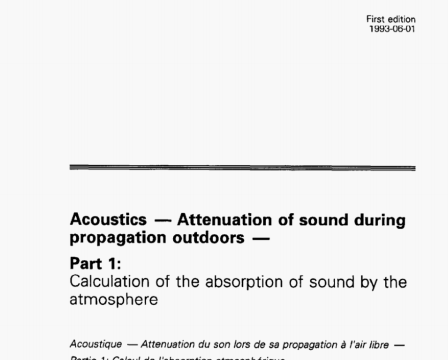ISO 9613-1 pdf download – Acoustics – Attenuation of sound duringpropagation outdoors 一 Part 1: Calculation of the absorption of sound by theatmosphere.
D.1.1 This annex describes a general spectrum- integration method to calculate tho attenuation by atmosphenc absorption applicable to fractional octave-band sound pressure levels. The method may be applied to various practical situations without the limitations given in 8.2.2.
D.1.2 A user of the method should be aware of practical limitations regarding such matters as the time required to carry out the computations and the fact that some sound pressure levels that might be calculated (or which should have been measured) may, ri fact, riot be measurable with commercially available instruments because of limitations imposed by the ambient acoustical background noise, the electrical noise floor of the instruments, or the inherent errors introduced by the use of practical bandpdss (lIters (see 8.1 .2). On the other hand, the method described in this annex, while more complicated than the approximate pure-tone method described in 8.2, can yield more acc*.irate estimates for frequency-band sound pressure leve(s than the pure- tone method.
D.1.3 The general features of the calculation method are described for three cases. For Case 1, band sound pressure levels are known at the location of a sound source and band sound pressure levels are to be determined at the location of a distant receiver. For Case 2. band sound pressure levels are known at a receiver and corresponding band sound pressure levels are to be determined at the source of sound. For Case 3, band sound pressure levels are known at a receiver for one set of meteorological conditions along the sound propagation path, and the band sound pressure levels are to be determined that would have been measured at the same location but under different meteorological conditions. For all cases, the calculation method described in this annex is limited to attenuation by atmospheric-absorption processes. Attenuation by other mechanisms is neglected.
D.1.4 The analytical procedures described in this annex assume that the bandpass filters were designed according to the base 10 system for midbared and bandedge frequencies, see equation equation (6). If the base 2 system was used, the applicable equations should be appropriately modified.
D.2.6 If the meteorological conditions are uniform over the sound propagation path from the source to the receiver, the pure-tone attenuation 8L(J) may be readily calculated at any frequency by application of the procedure indicated by equations (2) to (5). If the meteorological conditions aver the sound-propagation path are not uniform, the atmosphere should be modelled as a series of horizontal layers with average conditions specified over the thickness of each layer. The procedures given in C.3.) should then be followed to deterrnire the pure-tone atmospheric- absorption attenuation over the path for each frequency required to carry out the integration of equation equation(D.1) for each filter band and for each discrete-frequency component that may be present.
D2.7 The relative-attenuation response characteristics MO) in equation (D.1) for the filters used to establish the band sound pressure levels at the source should be the same as those for the filters at the receiver. The relative-attenuation response (i.e. filter attenuation minus the reference attenuation specified by the manufacturer) is preferably determined experimentally for each filter band or supplied by the manufacturer. Alternatively, analytical representations of the relative-attenuation response of a selected filter design may be utilized for evaluation of equation(D.1). Tho filtor manufacturer should be consulted for advice on analytical representations for the relative-attenuation responses of the filters in a spectrum analyser.
D2.8 The remaining items that need to be specified in order to evaluate the integral in equation CD.1) are the frequency limits and the size of the steps in a numerical integration between the lower and upper limits.
D.2.9 The relative-attenuation response of many practical filters is not symmetrical and is not the same for each filter band in a set of fractional-octave-band filters, the rate of change of attenuation with increasing frequency is often more rapid in the upper transition band (i.e. from the pessband toward the high-attenuation region of the upper stopband) than it is in the lower transition band. In addition, at law-to- mid frequencies in the audio-frequency range, the slope of the pressure spectrum level of many wide- band sound sources often is either slightly positive with increasing frequency or is nearly independent of frequency. At high frequencies (e.g. above approximately 1 kHz), the slope of the wideband pressure spectrum level is often negative. For those reasons, for general applications it is recommended that the frequency limits in equation (Dl) be set to.
ISO 9613-1 pdf download – Acoustics – Attenuation of sound duringpropagation outdoors 一 Part 1: Calculation of the absorption of sound by theatmosphere
